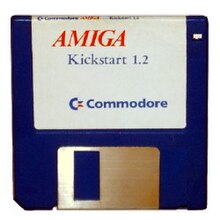Kickstart
The essential parts of the AmigaOS operating system , which are mostly located in the ROM, are called kickstart . Kickstart contains the exec.library (the kernel ), the dos.library (the DOS ), the graphics.library and the intuition.library (the system libraries for the Amiga GUI ).
Versions 1.0 and 1.1 of 1985 were only the Amiga 1000 shipped, originally in the form of a bootstrap - disk , which in a special RAM range ( WOM loaded), the protected after charging against overwriting and thus to the next Cold start could only be read.
Version 1.2 from 1986 was introduced with the Amiga 500 and the Amiga 2000 , the successor models of the Amiga 1000. With these models, Kickstart was no longer loaded from a floppy disk, but replaced by a built-in ROM. This reduced the boot time enormously. The disadvantage, however, was that to update to a new Kickstart version you had to open the computer and replace the module. Up to this point, Kickstart would fit in a 256 KiB ROM .
Later Kickstart versions were supplemented with device drivers for ATA , SCSI and PCMCIA hardware. From version 2.0, which was delivered with the Amiga 3000 and from version 2.04 also with the Amiga 500+, a larger ROM was therefore required, which now had a capacity of 512 KiB.
As of version 2.0, the disk validator , which was previously loaded dynamically from disk, has also been integrated into the ROM. This becomes active if a floppy disk is inserted that has not completed writing.
With a standard Amiga you can find Kickstart in the area of the memory addresses 0xFC0000 or 0xF80000 to 0xFFFFFF. However, this area is not permanently coded in the operating system, which is what so-called soft kickers take advantage of, which Amigas can start with a different Kickstart version, whereby this is loaded to a different address and their jump addresses are modified for this purpose.
The AmigaOS 4, which was released in 2006, still has the original architecture, only the kickstart modules are now on the boot data carrier from which they are activated by the bootloader.
Versions
However, the respective version of the kickstart is not displayed in the system with the known version number. If you enter the command "Version" on the command line, the system gives for example
Kickstart 40.63, Workbench 40.42
back. This means that OS 3.1 is running on this machine.

| Version number | Kickstart | comment |
|---|---|---|
| 23 | - | only for pre-series device "Velvet" |
| 24 | 0.4 | only on floppy disk for Amiga 1000 |
| 26th | 0.6 | only on floppy disk for Amiga 1000 |
| 27 | 0.7 | only on floppy disk for Amiga 1000 |
| 29 | 0.9 | only on floppy disk for Amiga 1000 |
| 30th | 1.0 | only on floppy disk for Amiga 1000 |
| 31 | 1.1 | only on floppy disk for Amiga 1000 (NTSC version) |
| 32 | 1.1 | only on floppy disk for Amiga 1000 (PAL version) |
| 33 | 1.2 | for Amiga 1000 only on floppy disk and in Amiga 500 and 2000 as ROM |
| 34 | 1.3 | for Amiga 1000 only on floppy disk and in Amiga 500 and 2000 as ROM |
| 35 | 1.3 | Special version for A2024 monitor |
| 36 | 2.0 | for the ECS chipset of the Amiga 500 Plus, Amiga 3000 |
| 37 | 2.04 | |
| 37 | 2.05 | for the ECS chipset with hard disk and PCMCIA support in the Amiga 600 as a ROM |
| 38 | 2.1 | did not show up |
| 39 | 3.0 | for the AGA chipset of the Amiga 1200 and Amiga 4000 |
| 40 | 3.1 | for the AGA chipset of the Amiga 4000T and the CD³² |
| 41 | 3.x | reserved for the Japanese version of WB 3.1 (localized with multi-byte characters) |
| 42 | 3.2 | reserved for alpha versions of WB 3.2 |
| 43 | 3.x | various patches for Kickstart 3.1 |
| 44 | 3.5 | for all Amigas, patches based on Kickstart 3.1, 44.4 Boingball 1, 44.5 Boingball 2 |
| 45 | 3.9 | for all Amigas, patches based on Kickstart 3.1, 45.2 Boingball 1, 45.3 Boingball 2 |
| 46 | 3.1.4 | for all amigas |
| 50 | 4.x | AmigaOS 4 Beta or MorphOS 1 |
| 51 | 4.x | AmigaOS 4 Beta (not published) or MorphOS 2+ |
| 52 | 4.0 | AmigaOS 4.0 |
| 53 | 4.1 | AmigaOS 4.1 |
Versions 1.2 to 3.1 are usually downward compatible with their predecessors.
All Amiga models except for the Amiga 1000 can accept Kickstart ROMs. There are also options to load Kickstart via software (rekick, softkick). Kickstart must contain drivers for the hardware of the target machine, otherwise some extensions cannot be used (e.g. IDE controller, PCMCIA connection, SCSI connection).



